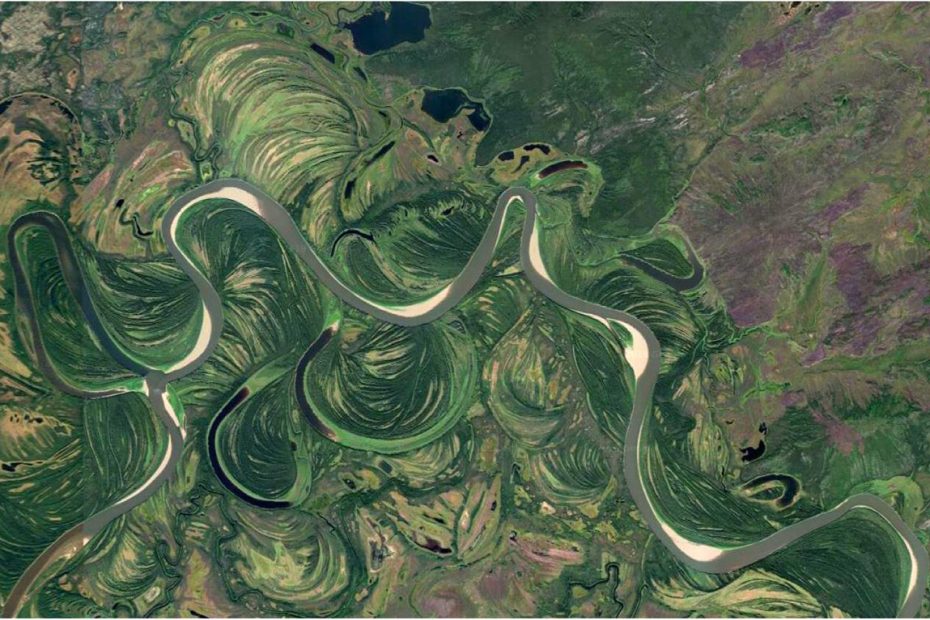When we imagine winding rivers cutting across landscapes, we usually picture lush banks filled with trees, grasses, and other greenery. But recent discoveries have revealed something astonishing: meandering rivers existed on Earth long before plants colonized the land. This finding reshapes our understanding of early Earth’s surface, climate, and even the role rivers played in shaping the planet billions of years ago.
The Surprising Discovery
Geologists studying ancient rock formations have found evidence of riverbeds that date back over 3 billion years—a time when Earth’s land was barren, devoid of plants, and covered mostly by bare rock, dust, and microbial mats.
Traditionally, scientists thought that meandering rivers—those with wide curves and looping channels—could only form once plants evolved. Vegetation stabilizes soil, traps sediment, and reinforces riverbanks, preventing streams from spreading out chaotically. Without plants, it seemed likely that rivers would simply erode in straight lines or spread into wide, shallow channels.
Yet the rock record tells a different story. Ancient sediments show distinct patterns—point bars, cutoffs, and curved channel deposits—that can only be explained by the action of meandering rivers long before terrestrial vegetation appeared.
How Rivers Meander Without Plants
The puzzle is: how could rivers bend and loop without plant roots holding the banks together?
Scientists propose a few explanations:
- Sediment Composition: Early rivers may have carried fine-grained sediments like mud and silt that naturally compact and resist erosion, mimicking the stabilizing effect of plants.
- Microbial Mats: Some researchers suggest that microbial life—thin, sticky films of bacteria and algae—may have coated surfaces, adding strength to riverbanks.
- Water Flow and Climate: Ancient rivers may have flowed under different conditions, with slower currents and different rainfall patterns that allowed for stable meandering even without vegetation.
These mechanisms highlight how dynamic early Earth was, even without the green landscapes we associate with rivers today.
What These Ancient Rivers Reveal About Early Earth
The existence of meandering rivers before plants tells us several important things:
- Active Hydrological Cycles: Water was moving across the land in complex ways billions of years ago, shaping valleys and redistributing sediments.
- Stable Landforms Without Plants: Landscapes were already capable of supporting long-lived river systems, even in barren environments.
- Clues About Early Atmosphere: The preservation of river deposits provides insights into rainfall, climate, and atmospheric conditions at the time.
- Lessons for Extraterrestrial Worlds: If meandering rivers can exist without plants, it means similar rivers may have formed on other barren worlds, such as Mars, which also shows evidence of ancient curving river channels.
A Window Into Earth’s Youth
Imagine standing on Earth 3 billion years ago. There are no trees, no grasses, not even moss. The land is rocky and barren, with only simple microbial life clinging to survival. Yet, across this alien-looking terrain, rivers snake and wind their way just as they do today.
These rivers would have carried sediments into basins, forming deltas and laying down layers that eventually turned into the rocks geologists study today. Over billions of years, those layers became time capsules, preserving the fingerprints of these ancient waterways.
Why This Discovery Matters Today
Understanding that meandering rivers existed before plants changes how scientists interpret ancient landscapes and climate models. It shows that vegetation was not a prerequisite for complex river dynamics, and it forces a reevaluation of how Earth’s surface evolved.
Even more exciting, it broadens our search for life and water on other planets. If rivers can meander without plants, then similar features seen on Mars may not just be random erosion patterns—they may represent once-living rivers carrying water across a plantless world.
Final Thoughts
The discovery of ancient meandering rivers predating plant life is a reminder that Earth’s history is full of surprises. Long before forests, grasses, and fertile river valleys, our planet already had rivers winding and curving across barren landscapes.
These rivers prove that water is an architect capable of shaping landscapes on its own—and that life, while transformative, is not always necessary for complexity to emerge.
In a way, these rivers are like Earth’s early sketches, carving paths that would one day nourish the green, thriving world we know today.
